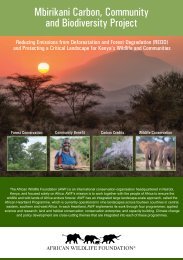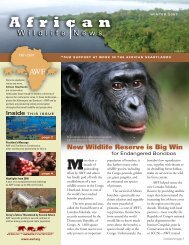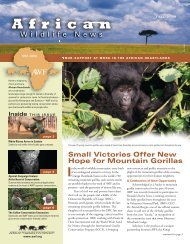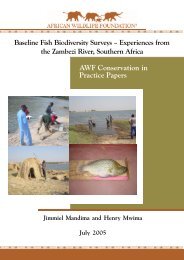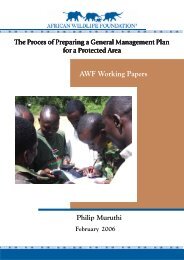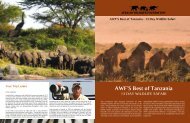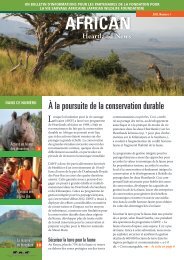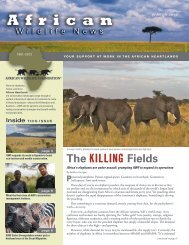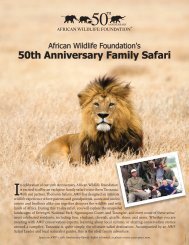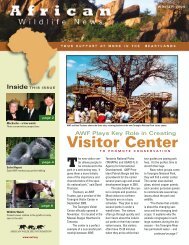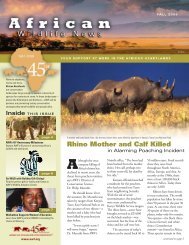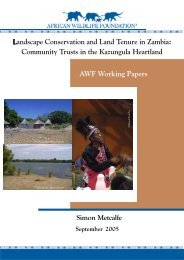Making a Difference? - African Wildlife Foundation
Making a Difference? - African Wildlife Foundation
Making a Difference? - African Wildlife Foundation
Create successful ePaper yourself
Turn your PDF publications into a flip-book with our unique Google optimized e-Paper software.
nations to the Convention on InternationalTrade Endangered Species (CITES) banned allcommercial trade in ivory.AWF experienced a number of board andstaff realignments during the decade. In 1981,Robinson McIlvaine retired as president aftereight years of service. He was succeeded byRobert Smith, conservationist and formerambassador to several <strong>African</strong> countries. Thatsame year, trustee Richard Jackson succeededKermit Roosevelt as chairman of the board.In 1984, trustee Toddie Lee Wynne, Jr., tookover as chairman. Paul T. Schindler, formerlywith the World Resources Institute, wasappointed AWF president, a post he wouldhold for nearly a decade. In 1988, AWF’sboard elected John Heminway, noted authorand television producer, as chairman followingWynne’s untimely death.In 1985, James Sherburn began a short stint asAWF director of <strong>African</strong> operations in Nairobi,succeeding Sandra Price. He was succeeded thefollowing year by Mark Stanley Price.By the early 1990s, multilateral donor institutionswere coming to rely heavily on the experience,adaptability and efficient administrationof AWF and other nongovernmentalorganizations (NGOs). USAID, the WorldBank, the United Nations Environment Programmeand the Netherlands governmentcalled on AWF to implement large resourceuseand conservation projects—often in cooperationwith government agencies such asTANAPA and the Kenya <strong>Wildlife</strong> Service.AWF itself introduced a new era in <strong>African</strong>conservation with its Heartlands program,which identifies large landscapes of exceptionalnatural value that can thrive only if localpeople benefit from the wild lands andwildlife around them.Even as AWF’s conservation efforts unfoldedon a more impressive scale, its longstandingdedication to education and trainingremained evident, as AWF continued to helptrain <strong>African</strong>s working in conservation in thefield. The organization’s most comprehensiveContinued on page 13Delaying action until a species is technicallyendangered shuts off options and pitsconservation and development interestsagainst one another.Amajestic lion looked out at readers fromAWF’s first national advertisement in Lifeand Time magazines during the summerof 1968 and early 1969. “This is a pictureof a lion,” read the caption. “Some day it may be allyou’ll be able to show your children.”The ad, which earned $30,000 for Tanzania’s nationalparks, reflected the objective of AWF’s founders: tohelp protect for future generations the magnificentwildlife heritage of Africa.In the past, Africa’s large predators—including lions,wild dogs and cheetahs—often were overlooked byconservationists until a specific population was threatened.Today, scientists understand that predators arean indicator of their habitat’s overall condition: Astrong predator population suggests a habitat thatpresents a healthy environment for all of its wildlife.<strong>Making</strong> this case to livestock-keepers is notalways easy. Although pastoralists are reasonablywildlife-friendly—they accept the presence of theoccasional elephant—conflict between predatorsand pastoralists is legendary.That’s what makes the northern Kenyan district ofLaikipia so interesting to AWF researchers: It is the onlyregion in Kenya where wildlife is actually increasingoutside protected areas. Instead of fencing their propertyand poisoning predators, most commercial ranchersin Laikipia and some traditional pastoralists welcomewildlife. Because residents have expressed an interestin maintaining and learning about their predator populations,the district is an ideal place to study carnivores,how and why they kill livestock in the midst of naturalprey and what people can do to reduce losses.Last year an AWF-supported scholar from theLaikipia Predators Project, directed by Laurence Frank,made national news. Based at Mpala Research Center,Mordecai Ogada has investigated new ways forranchers to protect their livestock from predators. Thesimple changes in livestock enclosures he suggestscould dramatically cut the number of livestock lost toMARK BOULTON/ICCEwhy arePredatorsimportant?MRSPAs Sally Patterson ChiefScientist, Philip Muruthioversees AWF’s predatorresearch projects.Laurie Marker foundedthe Cheetah ConservationFund, which has receivedAWF support.predators throughout east and southern Africa andreduce the number of “problem” lions, hyenas, cheetahsand leopards that are shot in revenge.Can humans learn to be more tolerant towardpredators? News from Amboseli National Park suggestssome progress in local attitudes toward lions.Poisoned out of the park some years ago, the lionsare now returning. AWF staff report that so far thereare no known instances of poisoning. ❍AWF Predator ProjectsAll of Africa’s large predators are threatened byshrinking habitats, overhunting and diseasespread by domestic animals and encroachinghuman settlements. In order to identify factors thatthreaten predator populations and ways to protectthem, AWF has funded leopard studies and supportedthe Cheetah Conservation Fund. AWF currentlysupports research on Ethiopian wolves, oneof Africa’s most endangered species, and wild dogs,which recently have returned to Laikipia and the Kilimanjaroregion. In the Zambezi Heartland, AWFfundedresearchers are exploring whether the huntingof “trophy” male lions is affecting the socialstructure of lion prides and the survival of cubs.CCF19971998• AWF establishesfirst ConservationService Center(CSC) in Arusha,Tanzania, and hiresa team of <strong>African</strong>professionals tohelp launch communitybusinesses• Charlotte ConservationFellowshipProgram honoringCharlotte KidderRamsay is createdto help <strong>African</strong> conservationistsattainadvanced degrees• Many aid workersdepart, but IGCPpersonnel remainto protect Virunga’smountain gorillas;no gorillas arekilled in 1996 andat least nine babiesare born• Angola, Namibia,Rwanda, Ugandaand Zimbabweinvolved in fightingin DemocraticRepublic of Congo•AWF’s first“Charlotte Fellows”complete their conservationstudies• AWF’s “Living withLions” projectexamines thecoexistence oflandowners andanimal predatorson Kenya’sLaikipia plateau• AWF ConservationService Centeropens in Nairobi• AWF marks anew era in <strong>African</strong>conservation withits Heartlandsprogram to protectlarge landscapes ofexceptional naturalvalueAWFF ALL 200111



